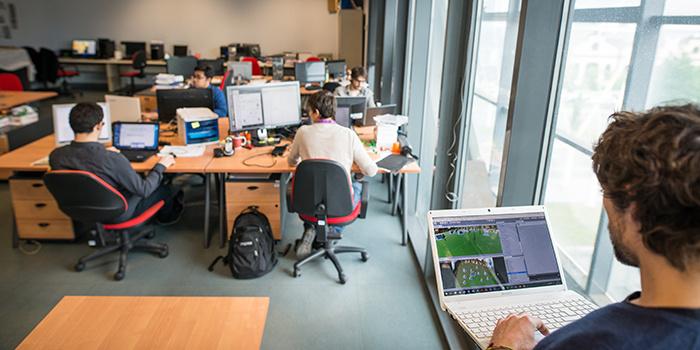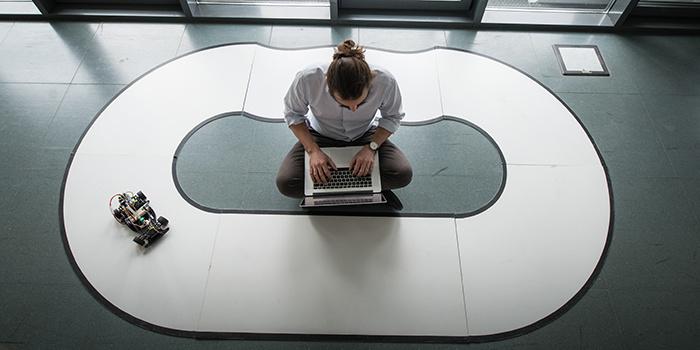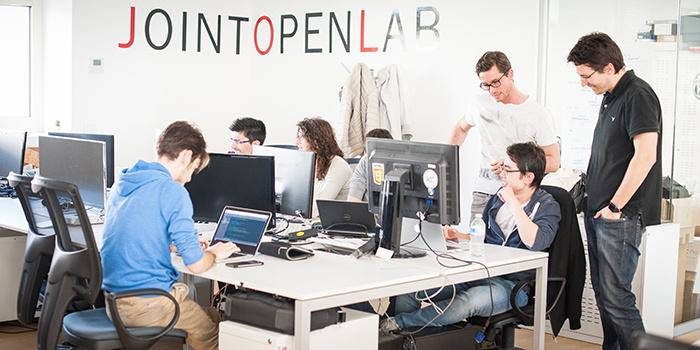
Office activities have always been recognized as low risk.
Nevertheless, statistics show a significant frequency of harmful events involving workers in office environments. Such harmful events can result from safety issues, such as falls, bumps against furniture, falling objects from shelves, etc., and health issues, such as maintaining poor ergonomic postures for extended periods or unsuitable microclimates for work.
To prevent the occurrence of these problems, the Prevention and Protection Service assists the technical structures of the administration and the departments in identifying the specific health and safety measures to be implemented in existing offices or new ones under construction.

Temperature in the workplace
The temperature of work environments must be appropriate for the human body during working hours, taking into account the methods of work applied and the physical efforts required from workers.
Ventilation
In enclosed workplaces, workers must have access to healthy air in sufficient quantities, preferably obtained through natural openings and, when this is not possible, with ventilation systems.
- Ensure an adequate number of air exchanges (opening windows for 5 minutes every 2 hours).
- Verify that regular maintenance and cleaning of filters and vents of the ventilation system are carried out.
- Do not obstruct air emission vents.
- Quickly eliminate sediments and dirt.
Lighting
- Unless it involves underground premises, workplaces must have sufficient natural light.
- All the aforementioned premises and workplaces must be equipped with devices that provide adequate artificial lighting.
- Consider window surfaces and lamps or reflective surfaces that could create reflection or glare phenomena.
Points of attention
- Direct glare from the presence of windows, luminous surfaces, or unshielded lamps within the worker's visual field.
- Indirect glare due to reflection from shiny reflective surfaces (metals, mirrors, etc.).
- Glare caused by contrast between illuminated surfaces and dark environments (e.g., a luminous signal in a dark room).
General conditions for well-being:
- Thermal comfort: recommended temperature 20°C in winter (18-22°C) and 26°C in summer.
- Avoid significant thermal shocks (max 6-7°C).
- Relative humidity 40-60%.
- Proper air exchange (natural/forced).
- Avoid exposure to drafts.
- Avoid excessively noisy environments.
- Adequate lighting (300-500 lux) with lamps equipped with anti-glare grids or screens.
- Windows with shading devices.
Prevention and Protection Service conducts inspections and measurements aimed at assessing potential discomfort conditions and collaborates to define any technical and organizational countermeasures to be implemented.

Definitions - Legislative Decree 81/08 Title VII
Video terminal operator: those who systematically and habitually use the video terminal for at least 20 hours per week, minus legally prescribed breaks.
Video terminal: an alphanumeric or graphic screen regardless of the type of display process used.
Workstation: the set that includes equipment equipped with a video terminal, possibly with a keyboard or other data entry system, including the mouse, human-machine interface software, optional accessories, connected devices, including the disk unit, telephone, modem, printer, document holder, chair, work surface, as well as the immediate surrounding work environment.
Risks associated with the use of video terminals
The employer, when assessing the risk, analyzes the workplaces with particular regard to:
1. Risks to vision and eyes:
- Incorrect lighting conditions.
- Incorrect placement relative to windows and light sources, resulting in glare, reflections, or excessive contrasts.
- Unfavorable microclimate (humidity, temperature, drafts).
- Incorrect adjustment of the software parameters of the screen.
- Non-ergonomic workstation.
- Close and prolonged visual effort.
- It is important to frequently look away from the screen to focus on distant objects.
2. Regarding posture and physical or mental fatigue issues:
- Spinal disorders caused by prolonged and/or incorrect sedentary positions.
- Muscular issues due to muscle soreness from poor blood circulation caused by static contracted positions.
- Hand and forearm issues due to nerve and tendon inflammation from overload or compression.
- Regularly alternate posture by adopting an upright position.
3. Ergonomic and environmental hygiene conditions.
The Work Surface
- Stable.
- Low-reflectance surface.
- Sufficient size to allow flexible arrangement of the screen, keyboard, and accessory materials.
- Height from the ground approximately between 70 and 80 cm to accommodate the lower limbs, as well as the seat and armrest entry, if present.
- The depth must ensure adequate visual distance from the screen and allow support for hands and forearms.
The Ergonomic Seat
- Stable.
- Seat height adjustable.
- Seat dimensions appropriate to the anthropometric characteristics of the user.
- Swivel mechanism to facilitate position changes and easy movement.
- Adequate support for the user's dorsal-lumbar region.
- Backrest with adjustable height and tilt.
- Both the backrest and seat must have rounded edges and be made of breathable, washable materials.
Dimensional requirements UNI EN 1335 -1
Type A Seat Greater adjustment options | Type B Seat Intermediate requirements and dimensions | Type C Seat Basic requirements and dimensions | |
| Minimum seat height | less than 40 cm | less than 42 cm | |
| Maximum seat height | greater than 51 cm | greater than 48 cm | |
| While seated, ability to adjust seat tilt and depth | necessary, minimum seat depth adjustment of 50 cm | not necessary | |
| While seated, ability to adjust lumbar support height (with fixed or mobile backrest) | necessary, minimum adjustment of 50 cm | no specific requirement | |
| While seated, ability to adjust backrest tilt | necessary | no specific requirement | |
| Internal distance between armrests | minimum 46 cm, maximum 51 cm | minimum 46 cm | |
| Minimum backrest width | greater than or equal to 36 cm | ||
| Minimum seat width | greater than or equal to 40 cm | ||
The screen
- Good image resolution.
- Stable image.
- Without flickering or trembling.
- Adjustable in orientation and tilt.
- Height adjustable.
- Clear shape and sufficiently large characters, with adequate spacing between them.
- Correct brightness contrast between the characters and the screen background.
- Easily adjustable to adapt to environmental conditions.
- No reflections or glare.
- Top of the screen at eye level and gaze perpendicular to the monitor at a distance between 50 and 70 cm.
Keyboard and mouse
- Separate from the screen and easily adjustable.
- Mechanism allowing to vary the tilt.
- Matte surface to avoid reflections.
- Key symbols must have sufficient contrast and be legible
- The mouse or other pointing devices should be placed on the same plane as the keyboard, in an easily reachable position, and have adequate space for use.
Portable VDT devices
Even for a notebook, it is important to set up the workstation by adjusting the chair, positioning and adjusting the screen, paying particular attention to the placement of windows or light sources that could cause glare or annoying reflections.
In case of continuous use of a notebook, the use of external keyboard and mouse is necessary.
VDT suitability
Before being assigned to operate a video-terminal, the worker must:
- Undergo a medical examination by the competent doctor and, if necessary, by an ophthalmologist.
- Follow-up examinations are mandatory, with a biennial frequency, for workers who have been found "fit with prescriptions or limitations" and for workers over the age of 50, and every five years in all other cases.
- At any time, each worker can request to undergo a check-up if they experience vision problems that could be related to the use of the video terminal.
The term toner refers to the very fine powder, black or colored, composed of particles with a diameter of 2 - 10 μm, used in photocopiers or printers.
In the printing and photocopying process that uses laser toner machines, the toner components are fixed onto paper through chemical and physical processes.
These processes can release airborne particles of toner and paper, ozone gas, and possibly volatile organic compounds (VOCs), which are emitted into the air.
Analysis of the Safety Data Sheets of the toners used at the Polytechnic and environmental measurements taken in various rooms indicate that:
- the toners used are not classified as hazardous materials,
- their proper use does not pose significant exposure risks to workers.
Regarding proper use, the ideal is considered to be:
- Place frequently used toner printers in well-ventilated areas,preferably where there is no continuous presence of workers, such as lobbies and corridors.
- In case of prolonged or intensive use of toner printers in poorly ventilated environments, it is advisable to ensure adequate ventilation of the room by regularly opening windows.
Finally, for operators whose main activity is changing toner cartridges, the Prevention and Protection Service has developed a specific operational procedure, based on the use of collective protective devices (toner aspirators, wet cleaning, etc.) and personal protective equipment (disposable FFP2 masks, gloves, possibly lab coats).

These are the risks that depend on so-called "business dynamics," that is, the set of working relationships, interpersonal interactions, and organizational structures that develop within a work environment. Work organization, for example, plays a fundamental role especially regarding the intensity of work from both a psychological and physical perspective, so the risks that may arise from it must be carefully evaluated by the Employer and the Competent Physician.
Developing appropriate tools to plan a fairer or more rewarding distribution of tasks can be excellent methods to improve working conditions:
- Clearly defined and universally known work processes.
- Participation in decision-making and operational autonomy.
- Assignment of tasks that can be performed according to individual capabilities.
- Opportunities to access training, education, or updates.
- Alternate monotonous and repetitive tasks with activities that require thinking.
- Avoid continuous work interruptions.
- Reduce environmental disturbance factors.
- Clarity in responsibilities.
- Effective communication among colleagues, collaborators, and superiors.
- Management of unresolved conflicts.
- Alternation and breaks in tasks involving direct contact with the public.
In recent years, a specific risk called "work-related stress risk" has been added to this classification of risks, which is considered one of the most difficult to identify due to the absence of an immediately detectable damage. This category mainly includes psycho-social risks that affect the emotional aspect of the worker.
Stress is defined as the state accompanied by discomfort and physical, psychological, or social dysfunctions resulting from the fact that people do not feel capable of overcoming the gaps related to demands or expectations placed upon them. In general terms, it is important to emphasize that stress is not a disease in itself, but rather a condition triggered in the human body by an external source or stimulus that causes a series of adaptations which, if prolonged over time, can take on a pathological character.
Translating the general concept to work environments, Work-Related Stress can be defined as the perception of imbalance felt by the worker when the demands of content, organization, and work environment, etc., exceed individual capacities to cope with such demands. In fact, there is a level of stress, at acceptable doses, that has positive effects on our body, allowing us to respond effectively and efficiently to external stimuli and to trigger an appropriate threshold of attention to environmental needs; however, prolonged exposure to stressors can pose health risks to the individual, both psychological and physical, reducing work efficiency (absenteeism, illness, transfer requests…).
It is important to emphasize and distinguish the concept of Work-Related Stress from that of Mobbing, understood as a systematic persecution carried out by one or more people with the aim of harming the victim to the point of job loss.
A second appropriate distinction to remember is related to the phenomenon known as Burn-Out, defined as: the pathological outcome of a stressful process that affects people who perform helping professions, when they do not respond adequately to the excessive stress loads that their work entails. This phenomenon, already known since the 1970s, is the pathological result of a combination of stress factors and subjective reactions that only affects those professions aimed at helping other people (doctors, nurses, lawyers, priests…) and leads the individual to "burn out" through a mechanism of excessive identification with the individuals involved in the professional activity, taking on their problems personally and thus losing the ability to distinguish between their own life and that of others.